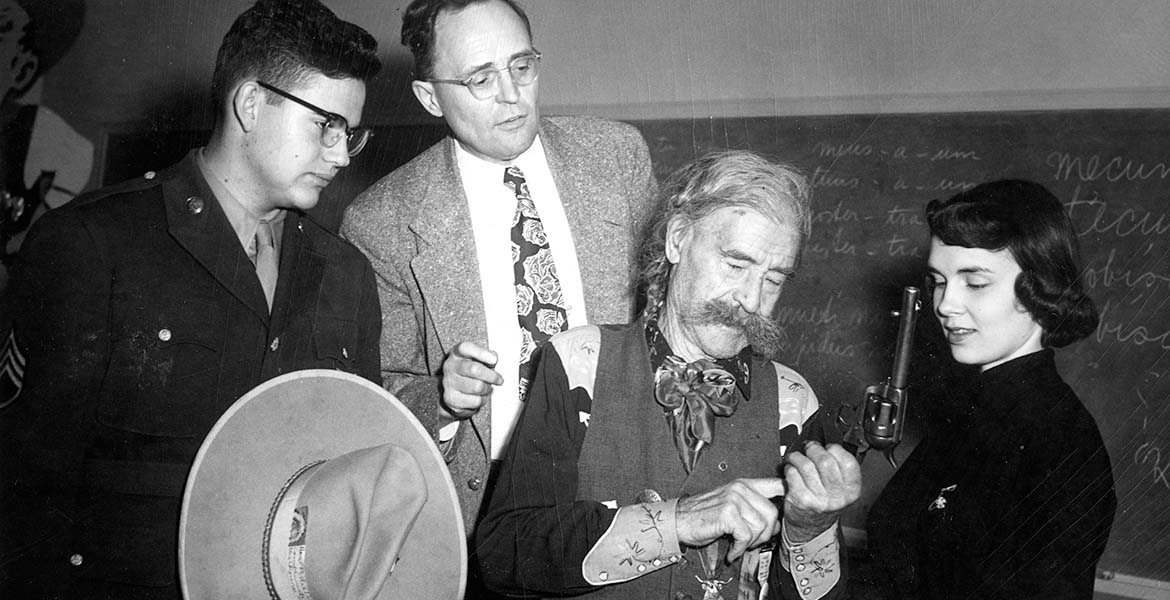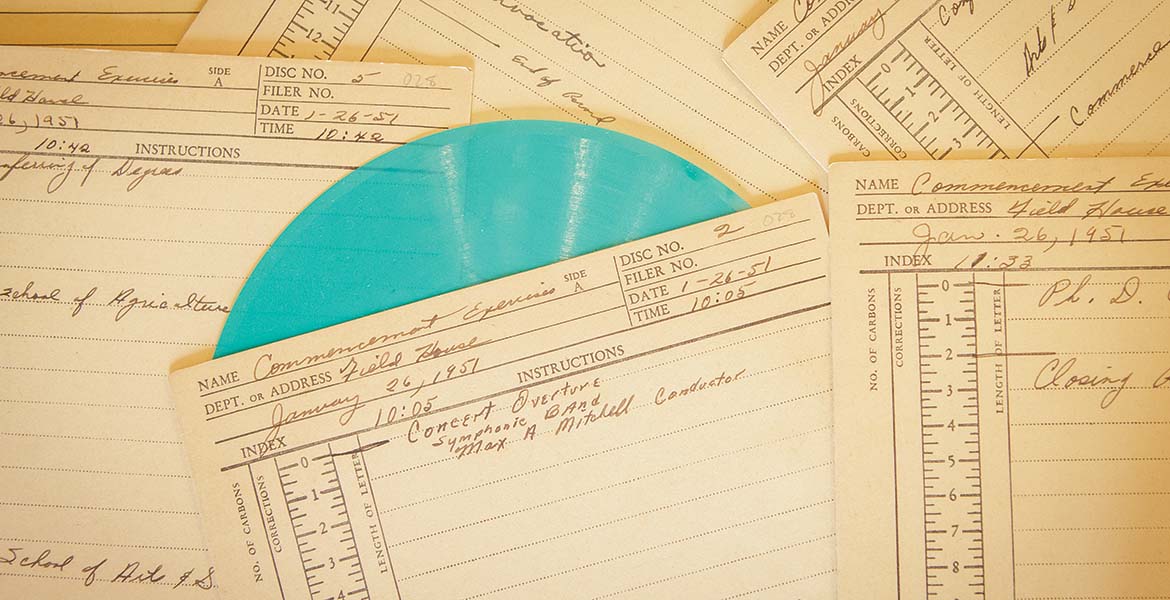
Cowboy Chronicles: Professor’s SoundScriber recordings offer audio treasures
Tuesday, December 14, 2021
Media Contact: Mack Burke | Editorial Coordinator | 405-744-5540 | editor@okstate.edu
Audio recordings of Oklahoma Agricultural and Mechanical College events and personalities collected before the 1940s are extremely rare.
A faculty member’s purchase in 1947 would provide one of the first opportunities to preserve sounds and voices from the college. Thomas Edison developed the phonograph 70 years earlier, but adaptations for the general public had been slow to develop and recording capabilities at OAMC were extremely limited.
Prior to this time, prices for most recording devices were very high, especially during the rationing of key materials during World War II, but in the years immediately following the war, new sound recording equipment would become more readily available and ensure that audio could be preserved locally.
Dr. Berlin B. Chapman was the OAMC history faculty member who bought the audio recording device known as the SoundScriber to capture and record presentations, lectures, ceremonies, meetings, interviews and special events on and off campus.
SoundScribers, first introduced in 1945, collected sounds from a microphone, converted them electronically and recorded the audio vibrations with a stylus pressing them into grooves on rotating soft green vinyl discs. A second stylus would be placed in these grooves to play the sounds preserved on the rotating discs. Each disc would store about 15 minutes of sound on each side. Initially intended for office dictation with limited playback potential, the grooves in the soft vinyl would develop increased distortion with use and quickly begin to lose their audio qualities.
Chapman first arrived in Stillwater in 1927, the year he completed his master’s degree in history from Harvard. Originally from Webster Springs, West Virginia, he was on the OAMC campus for three years before heading to the University of Wisconsin to earn a doctorate. Returning in 1941, Chapman would remain a History Department faculty member until his mandatory retirement at age 65 in 1966. He was active in the local Payne County Historical Society, serving as its president for 20 years and a member of the Oklahoma Historical Society Board of Directors for 16 years. Chapman encouraged his students to immerse themselves in local history, collect related records and share these stories through research papers, periodicals, books, presentations and memorial markers.

For years, Chapman interviewed notable local and state personalities as part of his research efforts, preserving these conversations with handwritten notes. His SoundScriber allowed him to record these exchanges and improve the accuracy of quotes taken from these interactions. Chapman was not a trained oral historian, and his interviewing techniques and documentation lacked the discipline’s standards of today, but his efforts over 70 years ago to engage in this format are laudable.
Wanting to document the variety of events occurring in and around the campus, Chapman’s first preserved recording occurred at the annual athletic banquet Sept. 12, 1947, and the next week recorded activities associated with freshman orientation. He would record baccalaureate services from 1948 through 1952 and college commencements from 1948 until 1954. Chapman and his recorder were also present at class reunions held in 1948 and 1952. College audiences would find the SoundScriber set up for celebrations such as the Student Union building dedication on Aug. 4, 1948, the groundbreaking for the new Home Economics Building on Feb. 12, 1949, and A&M President Henry Bennett’s 63rd birthday party on Dec. 16, 1949.
Chapman also recorded guest speakers in the college Auditorium. On Sept. 21, 1948, Tennessee Judge Camille Kelley shared her experiences and lessons learned from handling almost 50,000 juvenile court cases during her career that started in 1920. She had published the book “Delinquent Angels” the previous year but told audience they were under no obligation to purchase a copy. A few years after her visit to Stillwater, it was revealed that she had served as the judge in adoption cases for many of Georgia Tann’s child abduction operations, in which Tann had kidnapped and sold 5,000 children. Kelley was never charged and died in 1955.
After World War II, the college initiated a Great Issues speakers series. The theme for fall 1950 was “Which Way Progress” and featured former Georgia Gov. Ellis Arnall, former head of the Atomic Energy Commission David Lilienthal, Nobel Prize-winning author Pearl S. Buck and architect Frank Lloyd Wright.
Arnall had been elected governor at age 36. He led efforts to ratify a new state constitution, paid off the state’s debt, eliminated the poll tax, which had restricted voting as part of the state’s Jim Crow laws, and lowered the state voting age to 18, 20 years before it became the law nationally.
Lilienthal discussed his efforts with atomic and hydroelectric energy production. He previously published a report outlining guidelines for reducing the threat of nuclear weapons in the world and served as director of the Tennessee Valley Authority, which provided electricity to millions of Americans.
Pulitzer Prize-winning author Buck spoke on U.S. foreign policy in Asia, especially regarding China and the two Koreas. In October 1950, United Nations troops — 90 percent Americans — had pushed the North Korean army back to the border with China, prompting the Chinese army to enter the Korean War.
In her presentation, Buck articulated the numerous misunderstandings that had occurred between the Chinese communists and the United States in the preceding years and reflected on the challenges that lay ahead in the future. Wright canceled at the last minute. But for the Great Issues presenters who visited the OAMC campus, Chapman and his SoundScriber captured it all in audio.

On April 1, 1952, Chapman took his SoundScriber to Guthrie, Oklahoma, for an interview with Roscoe Dunjee, editor of the Black Dispatch. Chapman was interested in Dunjee’s perspectives on the integration of higher education in Oklahoma. They discussed and Chapman recorded Dunjee’s detailed description of the events surrounding the admittance of Ada Lois Sipuel Fisher to the University of Oklahoma Law School. It took three years from when Fisher first applied at OU for the case to work its way through the courts before finally being decided by the U.S. Supreme Court in Fisher’s favor. Dunjee had been personally involved with the case, accompanied Fisher to the OU president’s office in January 1946, raised funds for the case and worked with Thurgood Marshall who had been assigned the case as a lawyer with the National Association for the Advancement of Colored People (NAACP). Chapman’s interview took place less than three years after Fisher was finally admitted to OU, when the events were still clear to those involved.
Chapman taught Oklahoma history classes at OSU and interviewed two former Oklahoma governors. Henry S. Johnston retired to Perry, Oklahoma, and was interviewed in 1953 at the age of 85. Johnston was the second Oklahoma governor to be impeached and was later re-elected in the Oklahoma Senate, serving alongside many of the individuals who had been involved in his removal from office. The year before, Chapman had interviewed William H. “Alfalfa Bill” Murray. Murray, also in his 80s at the time of his recorded interview, rambled on for several hours about a variety of topics. When Chapman would attempt to change the subject, Murray would simply return to where he had left off in his extemporizations.
Some were invited to visit his Oklahoma history class. Frank Eaton joined Chapman’s classes on several occasions, and his presentation was recorded on March 27, 1956. Eaton, then in his 90s, always had an answer for the class’s questions. Eaton’s book, “Veteran of the Old West: Pistol Pete,” had been published four years earlier, and the students seemed very interested in his life experiences. Frank enjoyed the class and the attention and proved to be an entertaining guest.
In the 1980s, Chapman donated 372 discs covering 90 presentations and interviews recorded between 1947 and 1956 and his SoundScriber recording device, to the OSU Archives. They contain over 60 hours of audio. In 2013, the discs were sent to Scene Savers, a professional digital conversion firm in Kentucky. Overall, the voices and other sounds captured in the digital files were audible with minimal scratches and disruptions. Some discs were missing, and some had occasional blank sections with no audio, but what has been preserved is an invaluable treasure for generations of future listeners.
Photos By: OSU Archives and Gary Lawson
Story By: David C. Peters | STATE Magazine
